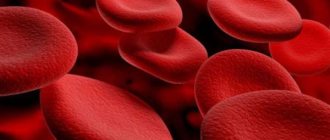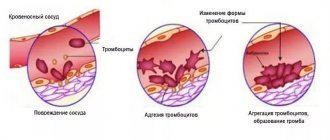11/01/2018 Category: Analyzes and examinations Author: Tatyana Rosinskaya
During the period of bearing a baby, it is very important that the woman is healthy, because the condition of the baby depends on this. An important indicator of the course of pregnancy is the number of platelets in the blood, i.e. the degree of its coagulation. According to statistics, thrombocytopenia (low platelet levels) occurs in more than 6% of pregnant women. Let's look at why this disease is dangerous and how to protect mother and baby from pathologies associated with a low number of platelets in the blood.
- Platelet levels in pregnant women
- Thrombocytopenia during pregnancy
Types of thrombocytopenia
- Main signs and causes of thrombocytopenia in pregnant women
Table: reasons that lead to a decrease in platelet levels
- How is thrombocytopenia treated?
Photo gallery: drugs to treat low platelet counts
What are platelets?
Platelets are cells of the circulatory system without a nucleus. Not even cells, but plates. Appear in the bone marrow. Under the influence of blood flow, their shape changes, resembling a circle or oval. The platelet cavity has a huge number of granules.
Blood cells live no more than ten days, but are of great importance for blood clotting. Platelets change shape when the integral structure of the vascular wall fails. When activated, the plate releases processes. Thanks to this ability, cells try to stop blood loss during injury and bleeding. In addition to participating in blood clotting, platelets will help tissue tighten by releasing growth factors. They also perform a protection function. It consists in the ability to dissolve the cell membrane of a foreign target.
The normal platelet level in the blood of a healthy person is 180 320 10 * 9 l, and in pregnant women it is 150 350 10 * 9 l.
The study is important because it determines the body's ability to cope with blood loss. If there is an increase in the concentration of blood cells, then we are talking about thrombocytopenia, when the levels are reduced (less than normal), thrombocytosis is diagnosed.
Normal platelet count in pregnant women
For women in the second and third trimester of pregnancy, the concentration of blood cells is less than the average of 120 10 * 9 l. This is because changes occur in the body of the expectant mother: blood volume has increased, and a placental circle of blood flow has appeared.
In the third trimester, a crisis occurs. Because during this period the platelet concentration drops to a critical level. And the question of how to increase them becomes relevant.
And before childbirth, the plates suddenly become active. They enable the blood to acquire the necessary viscosity and fluidity so that the birth goes smoothly. Nature tried to ensure that the mother’s body struggled with difficulties on its own. During childbirth, the blood is flowing, and after the end there is no need to even increase the indicators, it normalizes naturally.
A pregnant woman has difficulties with the level of concentration of blood cells in the blood.
- If your blood platelet levels are elevated during any trimester during pregnancy, you may be at risk for blood clots. This means you need to lower your platelet level. Otherwise, danger will lurk every minute.
- If studies show few blood cells in the plasma, pharmaceuticals that increase this number should be used. After all, even minor bleeding can lead to irreparable loss.
Causes of low levels of platelets in the blood of women during pregnancy
The main reasons for a low platelet rate in the blood are closely related to a lack of their production, destruction or consumption.
Low platelets during pregnancy appear against the background of the following events:
- unbalanced or malnutrition,
- red bone marrow hypoplasia,
- after severe intoxication and exposure to ionizing radiation,
- the viability of blood cells does not exceed seven days,
- a pregnant woman suffers from viral diseases,
- after taking pharmaceutical drugs,
- oncological pathologies,
- if there is a lack of folate and vitamin B12 in the body,
- in case of kidney failure,
- chronic form of hepatitis,
- after significant blood loss,
- allergic reactions in a pregnant woman and much more.
Signs
The clinical picture of pathology in pregnant women has a wider range of manifestations than in non-pregnant women. The longer the gestation period, the more intense and more often the unpleasant symptoms appear.
Signs:
- bruises, hemorrhages - often appear even at the slightest touch;
- small red rash on various parts of the body;
- nosebleeds, ear bleeding;
- bleeding gums, ulcers on the oral mucosa - sometimes such symptoms signal gingivitis in pregnant women, the level of colorless cells is normal;
- vascular network on the eyeballs, conjunctivitis.
The most dangerous manifestations are uterine and internal bleeding.
Symptoms of decreased blood platelet levels in a pregnant woman
A decrease in platelet concentration in women is observed externally:
- hematomas appear after minor physical impact on the skin, for example: when pressing,
- a rash may appear in the form of slight redness, which indicates multiple small hemorrhages under the skin,
- Gums may bleed when brushing teeth and eating,
- constant sudden bleeding from the nose,
- wounds bleed for a long time and do not heal,
- darkening of the stool, which indicates multiple hemorrhages,
- Blood may be discharged from the vagina.
These signs may appear from the 2nd trimester. And not necessarily in full force.
What tests are needed if platelets are low during pregnancy?
To diagnose low platelets during pregnancy, you must:
- Get examined by a hematologist.
- Take a general blood test to determine the concentration of platelets and their aggregation with ADP.
Aggregation is the process of combining several indicators into one system accounting.
- The blood clotting factor is determined.
- A laboratory blood test will determine the production of autoantibodies in the blood cells.
- Aspiration biopsy of bone marrow substance.
If platelet levels are low during pregnancy, tests can reveal the relationship of platelets with other blood cells and their incompatibility. As an additional research measure, a blood test for hymosiderin may be needed.
If, after a physical examination, a specialist reveals low or high platelets during pregnancy, it is necessary to perform a bone marrow biopsy. If the average platelet volume in the smear is increased, this means that there are blood cells in the spleen. A hematologist makes a diagnosis and prescribes a course of treatment.
Reviews from women
...Before the birth, the card said thrombocytopenia, hypotensive syndrome. My birth was full of fears. There was a strong fear of dying during childbirth, and there was a fear of ECS. There was no fear of pain, there was fear that something would go wrong. Apparently the hormones were playing havoc. But I, as best I could, still adjusted myself to the positive... I prayed to myself to give birth on my own, without a cesarean section. But it didn’t work out, a lot of time passed, labor weakened, they twisted my nipples with terrible force, pushing began and my baby was finally born... despite the large number of ruptures and the inability to sit for a month, I did not feel severe pain in the perineum. There was also no particular pain during uterine contractions; painful oxytocin injections were given a couple of times.
Anya
https://www.babyblog.ru/user/id1761629/362991
A friend carried the baby to term and gave birth via CS. Hormones were prescribed and constant monitoring at the Institute of Hematology and the Perinatal Center. It was very difficult, but they did it. Good health to you.
Katena Pashkina
https://deti.mail.ru/forum/v_ozhidanii_chuda/beremennost/trombocitopenija_1400681620/
...Platelets need to be monitored, coagulogram, hemostasiogram - sanguis, children's regional, our regional - good laboratories. Platelets have been low since when? Have you been referred to a hematologist? I gave birth to the eldest - it was about 100, the youngest was only 35 thousand (both by cesarean, without much blood loss even with such platelets, but it’s hereditary)
MishAninaMama
https://www.u-mama.ru/forum/waiting-baby/pregnancy-and-childbirth/511977/
In the last weeks of my pregnancy (the period was about the same as yours now), platelets began to fall, the hematologist did not see anything criminal, she only told me to drink vitamin C to strengthen blood vessels, I also took Fenyuls to maintain normal hemoglobin levels, there was no talk of any threat . During the contractions, placental abruption occurred, severe bleeding and a threat to the lives of me and the child, thanks to the doctors, they performed an emergency caesarean section on time and saved us, then they said that the problem was still low platelets. While you still have time, try to thoroughly figure out the issue with platelets so as not to put either yourself or your baby at risk. Health to you and your child
Nadejda_mur
https://vladmama.ru/forum/viewtopic.php?f=71&t=195790
For pregnant women, the normal platelet count is 100 and not 180. I had thrombocytopenia. First, ask for a complete blood count and a platelet count in the chamber. Now everywhere they count on a computer based on the diameter of their blood cells. I had very large platelets and therefore the computer mistook them for red blood cells. In the maternity hospital, the computer counted 45 for me, but in the cell it turned out that it was still 90. In general, it’s also not a lot, but the important thing is that there are more than 75, otherwise it is considered a pathology... If the clotting indicators are not impaired (this was exactly the case for me, then .e. there are few platelets, but they cope with their function), then they will leave you alone and tell you to take a general blood test once a month. I’ll also say that the day after giving birth my platelet count was 141, so there’s probably nothing wrong. At the maternity hospital they said that this happens often. It’s called gestational thrombocytopenia.
Asya











